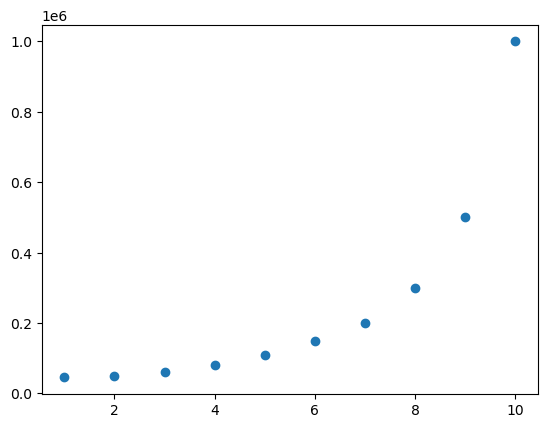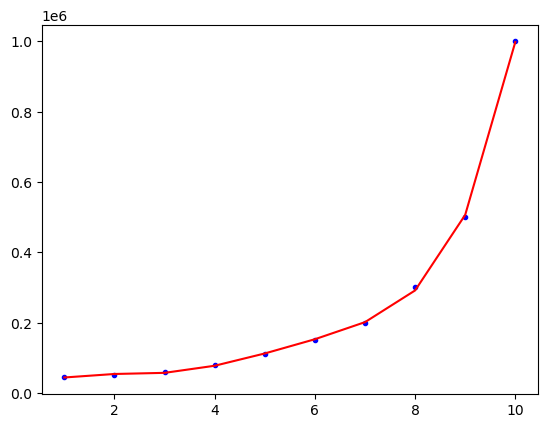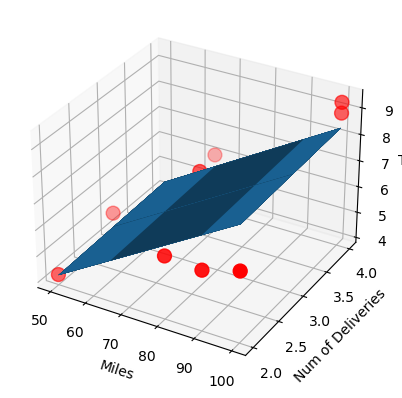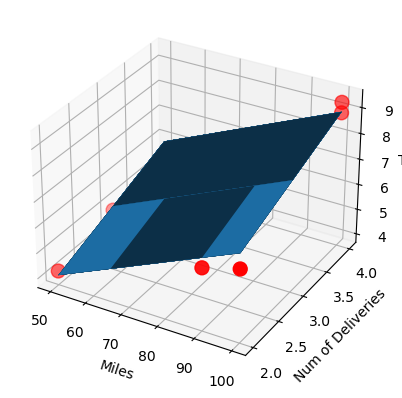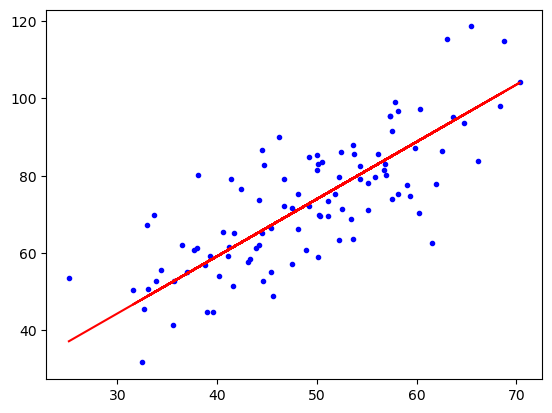1 | import pandas as pd |
1 | df = pd.read_csv("world_population.csv") |
1 | df[df["Rank"] < 10] |
| Rank | CCA3 | Country | Capital | Continent | 2022 Population | 2020 Population | 2015 Population | 2010 Population | 2000 Population | 1990 Population | 1980 Population | 1970 Population | Area (km²) | Density (per km²) | Growth Rate | World Population Percentage | |
|---|---|---|---|---|---|---|---|---|---|---|---|---|---|---|---|---|---|
| 16 | 8 | BGD | Bangladesh | Dhaka | Asia | 1.711864e+08 | 1.674210e+08 | 1.578300e+08 | 1.483911e+08 | 1.291933e+08 | 1.071477e+08 | 83929765.0 | 67541860.0 | 147570.0 | 1160.0350 | 1.0108 | 2.15 |
| 27 | 7 | BRA | Brazil | Brasilia | South America | 2.153135e+08 | 2.131963e+08 | 2.051882e+08 | 1.963535e+08 | 1.758737e+08 | 1.507064e+08 | 122288383.0 | 96369875.0 | 8515767.0 | 25.2841 | 1.0046 | 2.70 |
| 41 | 1 | CHN | China | Beijing | Asia | 1.425887e+09 | 1.424930e+09 | 1.393715e+09 | 1.348191e+09 | 1.264099e+09 | 1.153704e+09 | 982372466.0 | 822534450.0 | 9706961.0 | 146.8933 | 1.0000 | 17.88 |
| 92 | 2 | IND | India | New Delhi | Asia | 1.417173e+09 | 1.396387e+09 | 1.322867e+09 | 1.240614e+09 | 1.059634e+09 | NaN | NaN | 557501301.0 | 3287590.0 | 431.0675 | 1.0068 | 17.77 |
| 93 | 4 | IDN | Indonesia | Jakarta | Asia | 2.755013e+08 | 2.718580e+08 | 2.590920e+08 | 2.440162e+08 | 2.140724e+08 | 1.821599e+08 | 148177096.0 | 115228394.0 | 1904569.0 | 144.6529 | 1.0064 | 3.45 |
| 149 | 6 | NGA | Nigeria | Abuja | Africa | 2.185412e+08 | 2.083274e+08 | 1.839958e+08 | 1.609529e+08 | 1.228520e+08 | 9.521426e+07 | 72951439.0 | 55569264.0 | 923768.0 | 236.5759 | 1.0241 | 2.74 |
| 156 | 5 | PAK | Pakistan | Islamabad | Asia | 2.358249e+08 | 2.271967e+08 | 2.109693e+08 | 1.944545e+08 | 1.543699e+08 | 1.154141e+08 | 80624057.0 | 59290872.0 | 881912.0 | 267.4018 | 1.0191 | 2.96 |
| 171 | 9 | RUS | Russia | Moscow | Europe | 1.447133e+08 | 1.456173e+08 | 1.446684e+08 | 1.432426e+08 | 1.468448e+08 | 1.480057e+08 | 138257420.0 | 130093010.0 | 17098242.0 | 8.4636 | 0.9973 | 1.81 |
| 221 | 3 | USA | United States | Washington, D.C. | North America | 3.382899e+08 | 3.359420e+08 | 3.246078e+08 | 3.111828e+08 | 2.823986e+08 | 2.480837e+08 | 223140018.0 | 200328340.0 | 9372610.0 | 36.0935 | 1.0038 | 4.24 |
1 | specific_countries = ['Bangladesh', 'Brazil'] |
| Rank | CCA3 | Country | Capital | Continent | 2022 Population | 2020 Population | 2015 Population | 2010 Population | 2000 Population | 1990 Population | 1980 Population | 1970 Population | Area (km²) | Density (per km²) | Growth Rate | World Population Percentage | |
|---|---|---|---|---|---|---|---|---|---|---|---|---|---|---|---|---|---|
| 16 | 8 | BGD | Bangladesh | Dhaka | Asia | 171186372.0 | 167420951.0 | 157830000.0 | 148391139.0 | 129193327.0 | 107147651.0 | 83929765.0 | 67541860.0 | 147570.0 | 1160.0350 | 1.0108 | 2.15 |
| 27 | 7 | BRA | Brazil | Brasilia | South America | 215313498.0 | 213196304.0 | 205188205.0 | 196353492.0 | 175873720.0 | 150706446.0 | 122288383.0 | 96369875.0 | 8515767.0 | 25.2841 | 1.0046 | 2.70 |
1 | # filter country which contains United |
| Rank | CCA3 | Country | Capital | Continent | 2022 Population | 2020 Population | 2015 Population | 2010 Population | 2000 Population | 1990 Population | 1980 Population | 1970 Population | Area (km²) | Density (per km²) | Growth Rate | World Population Percentage | |
|---|---|---|---|---|---|---|---|---|---|---|---|---|---|---|---|---|---|
| 219 | 97 | ARE | United Arab Emirates | Abu Dhabi | Asia | 9441129.0 | 9287289.0 | 8916899.0 | 8481771.0 | 3275333.0 | 1900151.0 | 1014048.0 | 298084.0 | 83600.0 | 112.9322 | 1.0081 | 0.12 |
| 220 | 21 | GBR | United Kingdom | London | Europe | 67508936.0 | 67059474.0 | 65224364.0 | 62760039.0 | 58850043.0 | 57210442.0 | 56326328.0 | 55650166.0 | 242900.0 | 277.9289 | 1.0034 | 0.85 |
| 221 | 3 | USA | United States | Washington, D.C. | North America | 338289857.0 | 335942003.0 | 324607776.0 | 311182845.0 | 282398554.0 | 248083732.0 | 223140018.0 | 200328340.0 | 9372610.0 | 36.0935 | 1.0038 | 4.24 |
| 222 | 200 | VIR | United States Virgin Islands | Charlotte Amalie | North America | 99465.0 | 100442.0 | 102803.0 | 106142.0 | 108185.0 | 100685.0 | 96640.0 | 63446.0 | 347.0 | 286.6427 | 0.9937 | 0.00 |
1 | # set index to country |
| Continent | CCA3 | |
|---|---|---|
| Country | ||
| Afghanistan | Asia | AFG |
| Albania | Europe | ALB |
| Algeria | Africa | DZA |
| American Samoa | Oceania | ASM |
| Andorra | Europe | AND |
| ... | ... | ... |
| Wallis and Futuna | Oceania | WLF |
| Western Sahara | Africa | ESH |
| Yemen | Asia | YEM |
| Zambia | Africa | ZMB |
| Zimbabwe | Africa | ZWE |
234 rows × 2 columns
1 | # axis= is the vertical axis and axis=1 is the horizontal axis |
| Rank | CCA3 | Capital | Continent | 2022 Population | 2020 Population | 2015 Population | 2010 Population | 2000 Population | 1990 Population | 1980 Population | 1970 Population | Area (km²) | Density (per km²) | Growth Rate | World Population Percentage |
|---|
1 | # but axis=1 exists as 'Continent', 'CCA3' exist in the horizontal axis |
| Continent | CCA3 | |
|---|---|---|
| Country | ||
| Afghanistan | Asia | AFG |
| Albania | Europe | ALB |
| Algeria | Africa | DZA |
| American Samoa | Oceania | ASM |
| Andorra | Europe | AND |
| ... | ... | ... |
| Wallis and Futuna | Oceania | WLF |
| Western Sahara | Africa | ESH |
| Yemen | Asia | YEM |
| Zambia | Africa | ZMB |
| Zimbabwe | Africa | ZWE |
234 rows × 2 columns
1 | # This will return all the countries which contains "United" |
| Rank | CCA3 | Capital | Continent | 2022 Population | 2020 Population | 2015 Population | 2010 Population | 2000 Population | 1990 Population | 1980 Population | 1970 Population | Area (km²) | Density (per km²) | Growth Rate | World Population Percentage | |
|---|---|---|---|---|---|---|---|---|---|---|---|---|---|---|---|---|
| Country | ||||||||||||||||
| United Arab Emirates | 97 | ARE | Abu Dhabi | Asia | 9441129.0 | 9287289.0 | 8916899.0 | 8481771.0 | 3275333.0 | 1900151.0 | 1014048.0 | 298084.0 | 83600.0 | 112.9322 | 1.0081 | 0.12 |
| United Kingdom | 21 | GBR | London | Europe | 67508936.0 | 67059474.0 | 65224364.0 | 62760039.0 | 58850043.0 | 57210442.0 | 56326328.0 | 55650166.0 | 242900.0 | 277.9289 | 1.0034 | 0.85 |
| United States | 3 | USA | Washington, D.C. | North America | 338289857.0 | 335942003.0 | 324607776.0 | 311182845.0 | 282398554.0 | 248083732.0 | 223140018.0 | 200328340.0 | 9372610.0 | 36.0935 | 1.0038 | 4.24 |
| United States Virgin Islands | 200 | VIR | Charlotte Amalie | North America | 99465.0 | 100442.0 | 102803.0 | 106142.0 | 108185.0 | 100685.0 | 96640.0 | 63446.0 | 347.0 | 286.6427 | 0.9937 | 0.00 |
1 | df2.loc['United States'] |
Rank 3
CCA3 USA
Capital Washington, D.C.
Continent North America
2022 Population 338289857.0
2020 Population 335942003.0
2015 Population 324607776.0
2010 Population 311182845.0
2000 Population 282398554.0
1990 Population 248083732.0
1980 Population 223140018.0
1970 Population 200328340.0
Area (km²) 9372610.0
Density (per km²) 36.0935
Growth Rate 1.0038
World Population Percentage 4.24
Name: United States, dtype: object
1 | df2.iloc[3] |
Rank 213
CCA3 ASM
Capital Pago Pago
Continent Oceania
2022 Population 44273.0
2020 Population 46189.0
2015 Population 51368.0
2010 Population 54849.0
2000 Population 58230.0
1990 Population 47818.0
1980 Population 32886.0
1970 Population 27075.0
Area (km²) 199.0
Density (per km²) 222.4774
Growth Rate 0.9831
World Population Percentage 0.0
Name: American Samoa, dtype: object
1 | # sort by Rank and Country in ascending |
| Rank | CCA3 | Country | Capital | Continent | 2022 Population | 2020 Population | 2015 Population | 2010 Population | 2000 Population | 1990 Population | 1980 Population | 1970 Population | Area (km²) | Density (per km²) | Growth Rate | World Population Percentage | |
|---|---|---|---|---|---|---|---|---|---|---|---|---|---|---|---|---|---|
| 41 | 1 | CHN | China | Beijing | Asia | 1.425887e+09 | 1.424930e+09 | 1.393715e+09 | 1.348191e+09 | 1.264099e+09 | 1.153704e+09 | 982372466.0 | 822534450.0 | 9706961.0 | 146.8933 | 1.0000 | 17.88 |
| 92 | 2 | IND | India | New Delhi | Asia | 1.417173e+09 | 1.396387e+09 | 1.322867e+09 | 1.240614e+09 | 1.059634e+09 | NaN | NaN | 557501301.0 | 3287590.0 | 431.0675 | 1.0068 | 17.77 |
| 221 | 3 | USA | United States | Washington, D.C. | North America | 3.382899e+08 | 3.359420e+08 | 3.246078e+08 | 3.111828e+08 | 2.823986e+08 | 2.480837e+08 | 223140018.0 | 200328340.0 | 9372610.0 | 36.0935 | 1.0038 | 4.24 |
| 93 | 4 | IDN | Indonesia | Jakarta | Asia | 2.755013e+08 | 2.718580e+08 | 2.590920e+08 | 2.440162e+08 | 2.140724e+08 | 1.821599e+08 | 148177096.0 | 115228394.0 | 1904569.0 | 144.6529 | 1.0064 | 3.45 |
| 156 | 5 | PAK | Pakistan | Islamabad | Asia | 2.358249e+08 | 2.271967e+08 | 2.109693e+08 | 1.944545e+08 | 1.543699e+08 | 1.154141e+08 | 80624057.0 | 59290872.0 | 881912.0 | 267.4018 | 1.0191 | 2.96 |
| 149 | 6 | NGA | Nigeria | Abuja | Africa | 2.185412e+08 | 2.083274e+08 | 1.839958e+08 | 1.609529e+08 | 1.228520e+08 | 9.521426e+07 | 72951439.0 | 55569264.0 | 923768.0 | 236.5759 | 1.0241 | 2.74 |
| 27 | 7 | BRA | Brazil | Brasilia | South America | 2.153135e+08 | 2.131963e+08 | 2.051882e+08 | 1.963535e+08 | 1.758737e+08 | 1.507064e+08 | 122288383.0 | 96369875.0 | 8515767.0 | 25.2841 | 1.0046 | 2.70 |
| 16 | 8 | BGD | Bangladesh | Dhaka | Asia | 1.711864e+08 | 1.674210e+08 | 1.578300e+08 | 1.483911e+08 | 1.291933e+08 | 1.071477e+08 | 83929765.0 | 67541860.0 | 147570.0 | 1160.0350 | 1.0108 | 2.15 |
| 171 | 9 | RUS | Russia | Moscow | Europe | 1.447133e+08 | 1.456173e+08 | 1.446684e+08 | 1.432426e+08 | 1.468448e+08 | 1.480057e+08 | 138257420.0 | 130093010.0 | 17098242.0 | 8.4636 | 0.9973 | 1.81 |
1 | # sort by Rank in ascending and Country in descending |
| Rank | CCA3 | Country | Capital | Continent | 2022 Population | 2020 Population | 2015 Population | 2010 Population | 2000 Population | 1990 Population | 1980 Population | 1970 Population | Area (km²) | Density (per km²) | Growth Rate | World Population Percentage | |
|---|---|---|---|---|---|---|---|---|---|---|---|---|---|---|---|---|---|
| 41 | 1 | CHN | China | Beijing | Asia | 1.425887e+09 | 1.424930e+09 | 1.393715e+09 | 1.348191e+09 | 1.264099e+09 | 1.153704e+09 | 982372466.0 | 822534450.0 | 9706961.0 | 146.8933 | 1.0000 | 17.88 |
| 92 | 2 | IND | India | New Delhi | Asia | 1.417173e+09 | 1.396387e+09 | 1.322867e+09 | 1.240614e+09 | 1.059634e+09 | NaN | NaN | 557501301.0 | 3287590.0 | 431.0675 | 1.0068 | 17.77 |
| 221 | 3 | USA | United States | Washington, D.C. | North America | 3.382899e+08 | 3.359420e+08 | 3.246078e+08 | 3.111828e+08 | 2.823986e+08 | 2.480837e+08 | 223140018.0 | 200328340.0 | 9372610.0 | 36.0935 | 1.0038 | 4.24 |
| 93 | 4 | IDN | Indonesia | Jakarta | Asia | 2.755013e+08 | 2.718580e+08 | 2.590920e+08 | 2.440162e+08 | 2.140724e+08 | 1.821599e+08 | 148177096.0 | 115228394.0 | 1904569.0 | 144.6529 | 1.0064 | 3.45 |
| 156 | 5 | PAK | Pakistan | Islamabad | Asia | 2.358249e+08 | 2.271967e+08 | 2.109693e+08 | 1.944545e+08 | 1.543699e+08 | 1.154141e+08 | 80624057.0 | 59290872.0 | 881912.0 | 267.4018 | 1.0191 | 2.96 |
| 149 | 6 | NGA | Nigeria | Abuja | Africa | 2.185412e+08 | 2.083274e+08 | 1.839958e+08 | 1.609529e+08 | 1.228520e+08 | 9.521426e+07 | 72951439.0 | 55569264.0 | 923768.0 | 236.5759 | 1.0241 | 2.74 |
| 27 | 7 | BRA | Brazil | Brasilia | South America | 2.153135e+08 | 2.131963e+08 | 2.051882e+08 | 1.963535e+08 | 1.758737e+08 | 1.507064e+08 | 122288383.0 | 96369875.0 | 8515767.0 | 25.2841 | 1.0046 | 2.70 |
| 16 | 8 | BGD | Bangladesh | Dhaka | Asia | 1.711864e+08 | 1.674210e+08 | 1.578300e+08 | 1.483911e+08 | 1.291933e+08 | 1.071477e+08 | 83929765.0 | 67541860.0 | 147570.0 | 1160.0350 | 1.0108 | 2.15 |
| 171 | 9 | RUS | Russia | Moscow | Europe | 1.447133e+08 | 1.456173e+08 | 1.446684e+08 | 1.432426e+08 | 1.468448e+08 | 1.480057e+08 | 138257420.0 | 130093010.0 | 17098242.0 | 8.4636 | 0.9973 | 1.81 |
